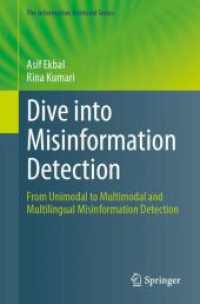- ホーム
- > 洋書
- > 英文書
- > Nature / Ecology
Full Description
Entomopathogenic Fungi in Insects: From Physiological Effects to Applications explores the complex relationships between entomopathogenic fungi and insects. This interdisciplinary book delves into the physiological, immunological, and behavioral responses elicited by fungi in insects, offering insights for sustainable development. It assesses the potential applications of these fungi as biopesticides against harmful insects while considering their impact on non-target populations. This comprehensive work is invaluable for researchers and professionals in agroecosystems, insect pathology, biocontrol, plant protection, and crop health, as well as graduate students focused on sustainability.
In addition, the book examines the mutualistic roles fungi can play in insect physiology, such as aiding in digestion. These fungi, prevalent in insect habitats, can serve as microbial pest control agents by infecting and weakening insect hosts. The book emphasizes the importance of mitigating potential harm to non-target insect populations, ensuring a balanced approach to biocontrol in agricultural practices.
Contents
1. Entomopathogenic fungi: outlook and forms of interaction with pest insects
2. Physiological and behavioral responses of insects to entomopathogenic fungi
3. Immune responses of insects to entomopathogenic fungi
4. Interactions of the entomopathogenic fungi with insect predators and parasitoids
5. Interaction of entomopathogenic fungi with insect vectors of plant diseases
6. Synergy between entomopathogenic fungi and other insecticides/metabolites in the control of insect populations
7. Biosafety of fungi on non-target organisms, especially pollinators and commercially beneficial insects
8. Application of entomopathogenic fungi for pest control








